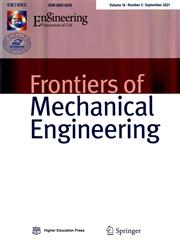Performance characteristics optimization of CRDI engine fuelled with a blend of sesame oil methyl ester and diesel fuel using response surface methodology approach
IF 4
2区 工程技术
Q1 ENGINEERING, MECHANICAL
引用次数: 1
Abstract
The primary aim of this experiment was to use response surface methodology (RSM) to optimize engine operating parameters for optimal performance and emission characteristics of a common rail direct injection (CRDI) diesel engine fuelled with sesame oil methyl ester (SOME)/diesel blends. The experiments were carried out on a water-cooled common rail direct injection engine with a 4-stroke, single-cylinder connected to an eddy current dynamometer. As input variables, the SOME% (0%–20%), fuel injection pressure (FIP) (500–600 bar), EGR rates (0%–14%), and engine load (0–12 kg) were used. The optimization method is utilized to maximize brake thermal efficiency (BTE) while minimizing BSFC, CO, HC, and NOx emissions. Experimental research data were used to create the RSM model through DoE (Design of experiments). The most relevant factors impacting the responses were identified using an ANOVA analysis. According to the optimization findings, the engine’s optimum working parameters were found to be a 20% SOME ratio, 577.5 bar FIP, 5.26% EGR rates, and 5.12 kg engine load. Under these operating circumstances, the optimal responses were determined to be 18.92% BTE, 0.3705 kg/kWh BSFC, 0.03190% vol. CO, 13 ppm HC, and 447.5 ppm NOx emission. At the same time, R 2 values were 96.35%, 87.54%, 91.57%, 95.87%, and 93.73% for BTE, BSFC, CO, HC, and NOx respectively. Graphical Abstract响应面法优化芝麻油甲酯与柴油混合燃料CRDI发动机性能
本实验的主要目的是使用响应面法(RSM)优化发动机运行参数,以优化以芝麻油甲酯(SOME)/柴油混合物为燃料的共轨直喷(CRDI)柴油发动机的性能和排放特性。实验是在一台四冲程单缸水冷共轨直喷发动机上进行的,该发动机与涡流测功机相连。作为输入变量,使用了SOME%(0%–20%)、燃油喷射压力(FIP)(500–600 bar)、EGR率(0%–14%)和发动机负载(0–12 kg)。优化方法用于最大化制动热效率(BTE),同时最小化BSFC、CO、HC和NOx排放。实验研究数据用于通过DoE(实验设计)创建RSM模型。使用ANOVA分析确定了影响反应的最相关因素。根据优化结果,发动机的最佳工作参数为20%的SOME比、577.5巴的FIP、5.26%的EGR率和5.12 kg的发动机负载。在这些操作条件下,最佳响应被确定为18.92%BTE、0.3705 kg/kWh BSFC、0.03190%vol.CO、13ppm HC和447.5ppm NOx排放。同时,BTE、BSFC、CO、HC和NOx的R2值分别为96.35%、87.54%、91.57%、95.87%和93.73%。图形摘要
本文章由计算机程序翻译,如有差异,请以英文原文为准。
求助全文
约1分钟内获得全文
求助全文
来源期刊

Frontiers of Mechanical Engineering
Engineering-Mechanical Engineering
CiteScore
7.20
自引率
6.70%
发文量
731
期刊介绍:
Frontiers of Mechanical Engineering is an international peer-reviewed academic journal sponsored by the Ministry of Education of China. The journal seeks to provide a forum for a broad blend of high-quality academic papers in order to promote rapid communication and exchange between researchers, scientists, and engineers in the field of mechanical engineering. The journal publishes original research articles, review articles and feature articles.
 求助内容:
求助内容: 应助结果提醒方式:
应助结果提醒方式:


